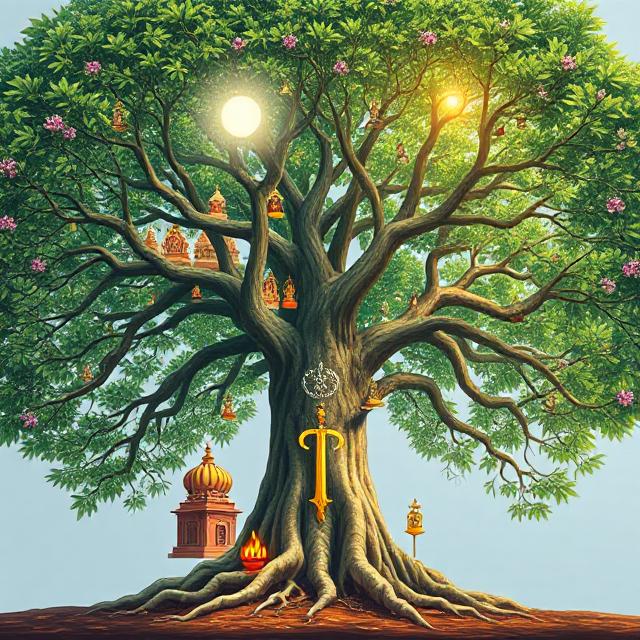
Table of Contents
Sikhism vs Hinduism: Shared Roots, Distinct Ideas
Sikhism vs Hinduism—it’s a comparison that often invites confusion due to the deep cultural overlap between these two religions. Both arose in the Indian subcontinent, share a similar cultural milieu, and exhibit common customs in daily life. Yet, they represent profoundly different worldviews. While Hinduism is one of the oldest religions in the world, deeply polytheistic and metaphysically diverse, Sikhism is a comparatively recent monotheistic faith founded in the 15th century with a strong emphasis on equality, service, and spiritual devotion to a single formless God.
To understand their relationship, we must examine their origins, theological principles, religious texts, spiritual practices, and ethical frameworks. Let’s explore where Sikhism and Hinduism intersect—and more importantly, where they diverge.
I. Historical Context and Origins
Hinduism
- Ancient origins (estimated 1500 BCE or earlier), rooted in Vedic traditions.
- No single founder; a broad, evolving set of beliefs known collectively as Sanatana Dharma (the eternal way).
- Deeply integrated into Indian civilization for millennia, influencing art, law, caste, and philosophy.
Sikhism
- Founded in 15th century CE by Guru Nanak in Punjab, a region with both Hindu and Islamic influences.
- Emerged as a reformist spiritual movement reacting to ritualism, caste, and sectarian divisions.
- Composed of Ten Gurus, ending with Guru Gobind Singh, who passed authority to the Guru Granth Sahib (scripture).
While Sikhism emerged within a Hindu cultural backdrop, it explicitly rejected many Hindu beliefs, especially the caste system and polytheism.
II. Conception of God
| Belief | Hinduism | Sikhism |
|---|---|---|
| Nature of God | Polytheistic, monotheistic, and henotheistic strands | Monotheistic: One formless, eternal God (Waheguru) |
| Divine Forms | Gods and goddesses: Vishnu, Shiva, Lakshmi, etc. | No images, idols, or anthropomorphic depictions |
| Liberation Goal | Moksha through karma, dharma, and rebirth | Union with God through Naam Simran (remembrance) |
Hinduism offers many paths to the divine—devotional, intellectual, ritual, and yogic—while Sikhism maintains a singular devotion to one God and sees all religious traditions as valid if they lead to truth and love.
III. Scripture and Language
Hinduism
- Multiple texts: Vedas, Upanishads, Bhagavad Gita, Puranas, and epics like the Ramayana.
- Written in Sanskrit and regional languages.
- Textual diversity reflects the pluralism of Hindu thought.
Sikhism
- Primary scripture: Guru Granth Sahib, a compilation of devotional poetry by Sikh Gurus and saints from other traditions.
- Written in Gurmukhi script and various dialects.
- Viewed as the eternal Guru and read as a living teacher.
Where Hinduism has countless sacred books serving different sects, Sikhism emphasizes a single, unifying scripture.
IV. Rituals and Practices
| Practice | Hinduism | Sikhism |
| Worship | Puja (idol worship), temple offerings | Meditation (Naam Japna), singing hymns (Kirtan), no idols |
| Sacred Spaces | Temples, shrines | Gurdwaras (community worship spaces) |
| Daily Discipline | Varies by tradition; may include rituals, fasting | Seva (selfless service), daily prayers, remembering God |
| Life Cycle Rites | Detailed rites for birth, marriage, death | Simpler ceremonies focused on God and community |
Sikhism avoids elaborate rituals, emphasizing inward devotion and ethical action. Hinduism’s diversity includes both ascetic and ornate ritual traditions.
V. Views on the Self, Soul, and Karma
- Hinduism: Believes in Atman (individual soul), rebirth, and karmic cycles. Liberation (Moksha) is release from samsara (the cycle of birth and death).
- Sikhism: Accepts reincarnation and karma, but stresses Naam Simran and surrender to God’s grace as paths to liberation.
Both accept rebirth and karma, but Sikhism rejects ritual purification and priestly intermediation as necessary.
VI. Caste and Social Ethics
- Hinduism: Traditionally upholds caste (varna) as a cosmic ordering of society, though modern reform movements challenge this.
- Sikhism: Strongly rejects caste and ritual hierarchy. All humans are equal before God. Langar (community kitchen) is a powerful symbol of this egalitarianism.
Guru Nanak’s teachings were radically inclusive in a caste-divided world, inviting people from all walks of life to spiritual equality.
VII. Symbols and Identity
Hinduism
- Diverse symbols: Om, Swastika, Trishul, tilak marks, sacred threads.
- Visual expression of deities, stories, and spiritual roles is common.
Sikhism
- Distinct identity symbols: The Five Ks (Kesh, Kara, Kanga, Kachera, Kirpan) defined by Guru Gobind Singh.
- Emphasis on a warrior-saint ideal: spiritual devotion paired with social courage.
Sikhism codified a uniform spiritual identity as a form of resistance and cohesion under persecution.
VIII. Gender and Social Roles
- Hinduism: Mixed legacy—ancient scriptures give both empowering and patriarchal roles to women.
- Sikhism: Guru Nanak declared spiritual equality of women from the beginning. Women can lead prayers and community service without restriction.
While Hindu society has evolved over time, Sikh teachings directly oppose gender discrimination as antithetical to divine truth.
IX. Converging Points and Coexistence
Despite theological contrasts, Sikhism and Hinduism have coexisted for centuries:
- Shared festivals like Diwali and Holi are celebrated in parts of India.
- Many Sikhs have Hindu ancestry, and cultural practices overlap.
- Philosophical cross-pollination—Bhakti poets and saints are revered across traditions.
Yet it is important to respect Sikhism’s distinct identity, especially as it emerged to reject ritualism, caste, and exclusivity.
X. Conclusion: A Tale of Difference Within Familiarity
Sikhism vs Hinduism is not a case of two versions of the same religion. While sharing a common civilizational backdrop, they offer contrasting visions of divinity, society, and spirituality. Hinduism’s pluralism allows for many gods and paths; Sikhism stands firmly on oneness, equality, and devotion without ritual intermediaries.
Both have given the world profound spiritual insights. But their comparison reminds us of something deeper: that truth wears many garments, and understanding comes not from collapsing differences—but from appreciating them in full clarity.